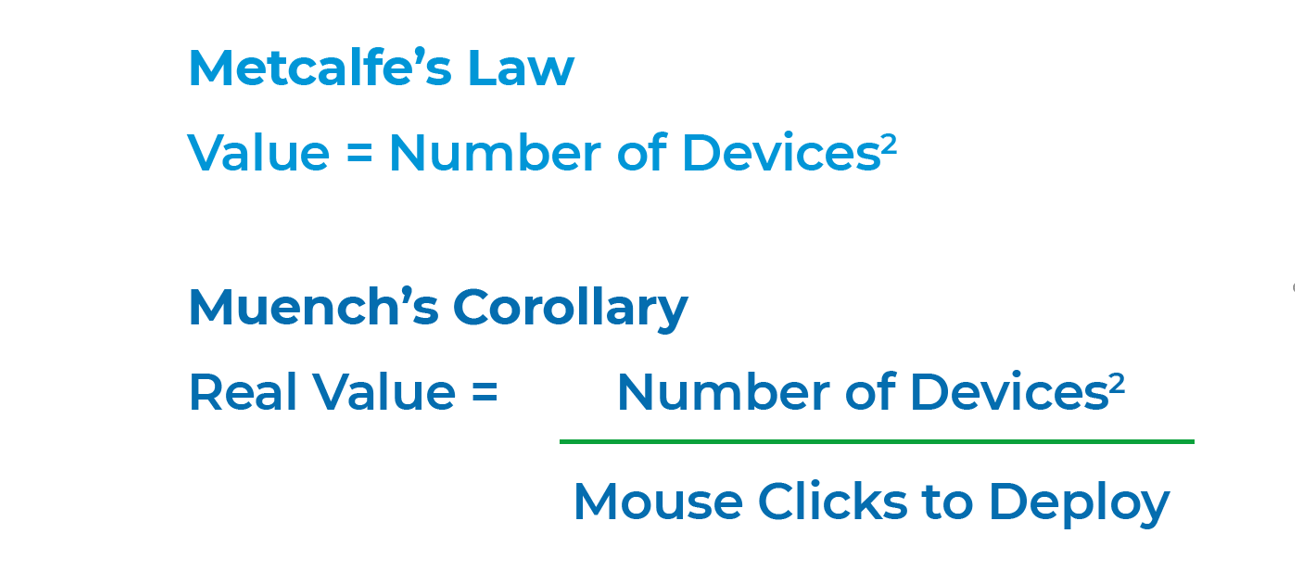
Value creation is happening in the buildings industry as OEMs, System Integrators, and End Users transition to an open, industry-standard methodology for meta-data tagging and data modeling. The BAS industry is reworking how data is leveraged across the entire design-construction-operations cycle; new applications that use tagged data are now being introduced and building owners are reaping financial rewards across familiar activities and through new services. Metcalfe's Law is one way to predict how the value of technology is realized.
This observed rule of technology market behavior holds that the value of a network increases in proportion to the square of the number of connections. However, applying this to smart buildings and IoT devices, this doesn't tell the whole story. Historically, it has required a large amount of manual configuration and integration effort to derive value from these devices and their applications. Here's my theory:
In other words, if traditional building automation systems require a large amount of effort to deploy, then that diminishes the value of the connected devices. If we can leverage the use of tagging and data modeling to drastically reduce the number of mouse clicks, the "real value" of a smart building can be realized. This is why the Project Haystack community and J2 Innovations are focused on smarter software and more efficient workflows.
Traditionally, System Integrators are responsible for defining automation system points; yet, few of these professionals have ever wrangled with data semantics, metadata tagging, and taxonomies.
Most have specialized in working on a single brand of building automation system (BAS) and have never encountered the issues that arise when you try to combine data from different sources and bring it into value-added applications.
For example, a large college campus with many different BAS systems installed over many years could have dozens of ways to describe something as simple as its zone temperature.
With Project Haystack methodology and the right tools for automating the tagging process, systematic tagging and data modelling can be a straightforward job, even for a very large data set. Will the payoffs be worth the effort? Yes, many times over.

Muench's Corollary to Metcalfe's Law - Network value equals the square of the number of connections divided by the number of mouse clicks that takes to connect the devices.
In other words, if traditional building automation systems require a large amount of effort to deploy, then that diminishes the value of the connected devices. If we can leverage the use of tagging and data modelling to drastically reduce the number of mouse clicks, the "real value" of a smart building can be realized. This is why the Project Haystack community and J2 Innovations are focused on smarter software and more efficient workflows.
Project Haystack is an established open source initiative whose mission is to provide the building automation industry and related IoT applications with a standardized way of defining the context and meaning of building and equipment related data. Project Haystak just realeased Haystack 4.0, which adds data-modelling features that support the implementation of both a taxonomy and the resulting ontologies that define the relationship of things and between things.
A popular implementation of open-source Project Haystack is nHaystack. This module enables Tridium Niagara stations JACE and WebSupervisor to serve Haystack data via RESTful protocol. Using nHaystack, applications receive data complete with essential metadata descriptors. With a Haystack-tagged system, you can define tags once and realize value over and over again. Haystack makes it easier for system integrators to add meaning to the Java-based Niagara component.
There are numerous other implementations being worked on by the Project Haystack community too. For example, there are groups working in C++ and DART. All share the common goal of making it easier to unlock value from the vast quantity of data being generated by the smart devices that permeate our homes, buildings, factories, and cities. The way forward starts with defining tags for the most common types of points, devices, and their relationships. The resulting self-describing models will pay off at the device, equipment and building levels, as well as when they are shared by various applications for visualization, control, fault detection, analytics, maintenance ticketing, room scheduling, etc.
As we alluded to before, there are many payoffs of using the Haystack standard. The real-world value of using tagging and data modelling can be seen through these examples - or "Payoffs".
To illustrate, consider how a standard VAV for an air handler would be defined in Haystack. You would start with a device template that associates the points with all the standard attributes: air flow, supply air temperature, damper position, set point.
There is great value in just having this device-level information model at hand when diagnosing a problem. For example when an occupant calls to report 'It's too cold in this room,' the points graphic would display in a normalized way the live values, independent of how they were defined and named at the control system level. With this knowledge, such situations can be easily and quickly diagnosed and addressed, often without a costly truck roll.
Tags that reflect relationships are also useful, for instance how devices interrelate as part of a larger system. Relationship, or reference tags can also represent dependencies of equipment to floors, floors to buildings, buildings to enterprises, etc. For example, reference tags can be used to build the hierarchical relationships of all the VAV's in a particular air handler system. This makes it possible to call up equipment summaries. Anomalies are particularly easy to spot when they are presented in the context of other similar devices.
Once you have built a set of self-describing models according to the standard Haystack methodology, you are in a good position to apply applications that take advantage of Haystack tags. These automatically plug the relevant operational data into the right place. The resulting app provides a user experience for navigation, point graphics, summary graphics, schedules, histories, alarms - in effect, all the information captured in the models delivered to any device anywhere. Clear, non-ambiguous information can go a long way toward simplifying the jobs of maintenance staff and facilities managers which is another way your investment in data modelling will pay back.
The return on investment increases when automatic control functions enabled by a tagged and modelled system come into play. For example, many building operators have the opportunity to save significant energy costs through participation in demand response programs. However, orchestrating whole-building control, given the various data silos and subsystems (HVAC, lightning, enterprise scheduling) has been difficult and costly to implement. By using the Haystack method, you can simply tag models for all of the equipment that needs to be controlled and tag the corresponding control sequence and it will 'just work'. This drastically reduces the traditional amount of time, labor and cost required to implement control strategies across the building.
One of the most important but time-consuming tasks for implementing an intelligent building is the initial checkout and on-going retro-commissioning. Tag based automated commissioning gives you the ability to create a set of tasks and apply them globally across an entire system of equipment. Each step is executed automatically and the results are summarized in a checkout/ commissioning report. No more spending hours manually checking sensors, stroking dampers, and recording results.
When you apply analytics software to a well-designed and deployed tagging and data modelling strategy, you get automatic data analysis for building, energy and equipment data and thus derive more value from your investment. Data analytics creates value by detecting patterns that represent opportunities for improved performance and cost savings. Automated analytics software will identify issues, patterns, deviations, faults and opportunities at the device, equipment and whole-building levels.
Correcting problems quickly and optimizing the delivery of building services reduces energy bills and contributes to the type of well-run facility that keeps occupants productive and satisfied with their space.
When all building data is structured in a Haystack-compliant database, integration of building operations and other aspects of workplace management in an enterprise setting is easier. Tagging also helps service activities like issuing maintenance tickets by automatically linking relevant information to the corresponding application. Integrating building management within the larger IT infrastructure leads to additional cumulative benefits felt from the C-suite level to every member of the operations and maintenance staff.
Tags can be applied at the server level using software tools to convert legacy devices and points to Haystack compliant data records. As Project Haystack adoption has grown, and implementation have expanded beyond the server, tags now exist in network controllers as well. As more IoT devices enter the market that utilize Project Haystack, we will see more end devices that natively support Haystack tags.
The FIN Framework application suite incorporates a unified toolset that makes it easy to do Haystack tagging and data modelling utilizing libraries and templating. Users can easily convert the data from all their non-Haystack legacy global and field controllers to Haystack-able models. FIN enables automatic tagging and optimized workflows, drastically reducing the number of mouse clicks and helping realize the real value of the network.
With software that leverages tagging and data modelling, we are beginning to greatly reduce the number of mouse clicks required to implement a solution. Following Muench's Corollary to Metcalfe's Law, this streamlining of the user experience is unlocking the true value of a connected system. Participation in Project Haystack is giving property managers, building owners, and system integrators a big head start in the establishment of an in-house point taxonomy. They can then enforce vendor specifications that call for standardized tagging and data modelling across a portfolio and for all aspects of building operations. Project Haystack is supported by an active and growing open-source community of developers who are collaborating on improving its definitions and modelling methodology. For all these reasons, it is the most future-proof approach to monetizing your building data.
Scott is well known as an industry expert in smarthomes and smart buildings. He is past president of ASHRAE, and is currently a board member for Project Haystack. He attended Clarkson University for Mechanical Engineering and graduated University of Phoenix with a BS/Business in Organizational Innovation. Scott joined J2 Innovations as a partner in 2011, and is now Vice President of Customer Experience. He has a wide range of responsibilities including evangelism, business development, training, and operational excellence.
